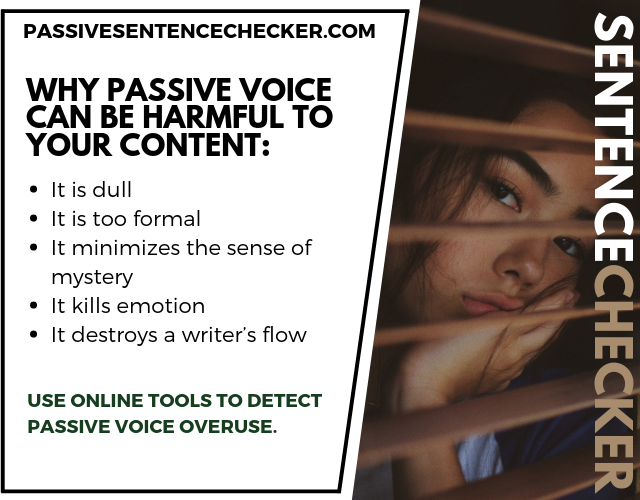In the English language, there are varying voices used when it comes to writing content. However, the most commonly used voices by writers are the active voice and the passive voice. That is the importance of the free passive voice checker to help you determine the difference between the two entities.
Each voice, nonetheless, has its own application in the realm of writing. And this depends on how you look at it from one scope to another.
In most forms of writing, individuals tend to use the active voice over the passive voice. As a matter of fact, the active voice has gained quite the following among professional writers today. That’s why a passive voice misuse fixer plays a critical role in the process.
But this doesn’t mean that the passive voice does not come in handy in some situations.
If you’re a first-time writer though, it is highly encouraged that you stick to the active voice.
5 Ways the Passive Voice Can Be Harmful to Your Content
Here are some of the reasons why the passive voice is not preferred in content. Indeed, it is these reasons that make it important to know how to fix passive voice misuse.
- It is dull: The passive voice tends to create a sense of monotony with your content hence it can easily put readers off and make them lose interest in what you are talking about. That’s why it’s vital to know how to fix passive voice in an essay.
- It is too formal: If you’re dealing in the realm of media and entertainment, the passive voice can be pretty boring because it tends to have a formal tone to it which can instantly be a put off amongst leisure readers. This is especially the case if you’re running an online blog or magazine. As a matter of fact, most media and entertainment magazines employ a fix passive voice tool to deal correctly with content.
- It minimizes the sense of mystery: The passive voice tends to have a straightforward feel to it. Ideally, the content only speaks in a manner that conveys information without evoking curiosity in the reader.
- It kills emotion: Additionally, the passive voice tends to instantly kill emotion because of its straightforwardness. This is one of the reasons why the news likes to use this style of writing to report a tragedy or a disaster. Indeed, if the media was to use the active voice in reporting the news, more people would be inclined to feel some sense of emotional attachment to it.
- It destroys a writer’s flow: Flow is very important when it comes to writing. As a matter of fact, flow is one of the reasons why the most successful writers have best-sellers. Unfortunately, the passive voice is infamous for destroying the ebb and flow of writers. In turn, it can be very difficult to complete an exhilarating story in the passive voice!
Why Is It Improper to Write in Passive Voice in Your Text?
Indeed, you can notice that you have used too much passive voice in your text when the content in these two major instances:
- When the subject is performing the action: This is the major red-flag of the passive voice. What this simply means is that you the subject of any sentence is the one that is performing the action verb on a particular object. For example, Phillip washed the cat where Phillip, the subject is performing the act of washing. This is easy to spot, especially if you’re using a fixing passive voice app.
- When you are missing an auxiliary verb in your sentence: In most, if not all instances of the active voice, the auxiliary verb ‘t0 be’ is used regardless of the tense. For example, in the aforementioned sentence, Phillip washed the cat, when we change to active voice, it goes something like this: the washing of the cat WAS done by Phillip. As you can see, we have introduced the auxiliary verb ‘to be’ in the content but in the past tense.
How Does One Know How to Fix Passive Voice Misuse in Content?
Here are some of the ways you can detect and eliminate passive voice in your content easily:
- Know where the subject of the sentence is: By understanding where the subject of the sentence is, you can easily deduce the issue and proceed to eliminate passive voice!
- Look for the subject in the sentence: The first critical way to determine how to remove passive voice is to know the subject of the sentence. As stated earlier, the passive voice is present when the subject performs the action on a given verb. For example, John kicked the ball. Here, we can see that John is the subject and that the kicking of the ball is done by him on the object.
- Look for the verb in the sentence: Secondly, knowing the action verb is vital in helping you differentiate between the subject and the object. Still using our first example, we can see that the object, in this case, is the ball because it is the one that is being kicked by the subject, John.
- Find the object of the sentence: We can tell from the first example that the object is the ball because it is the one subjected to the action by the subject. Hence, this enables us to see exactly how the passive voice has been played out, and how determining these factors will help us move successfully to the active voice. Indeed, we can easily do all this with an active and passive voice corrector.
3 Effective Ways to Change from the Passive Voice to the Active Voice
That being said, here are three effective ways we are able to effectively change the passive voice into the active voice with wordy sentences
- Changing the focal point of focus to the verb: The first process is to make the verb the main point of focus in the sentence. We do this by making the subject to be performed on by the action verb. See from the example below:
- The boy caught the fish
- The fish was caught by the boy.
The first example is in passive voice while the second is in the active voice. From the two examples, it is clear that in the second sentence, the verb is the main focal point of the active sentence.
- Adding an Auxiliary Verb to the Sentence: Additionally, we add an auxiliary verb ‘to be’ in the sentence when we want to convert from the passive voice to the active voice.
As you can see in the aforementioned example, the auxiliary verb ‘to be’ is added as was in the past tense.
- Using A Passive Voice Corrector: Last but not least, we can use a passive voice fixer tool to make the necessary adjustments while correcting from passive voice to the active voice.
And there you have it! Hence, if you would like to access the beneficial features of our passive voice fixer tool, get in touch with us today!











